Taking Bit Deer as an example, exploring the integrated integration path of the overseas Bitcoin mining industry
Author: Jishi Communication
After nearly two rounds of bull and bear fluctuations and policy cycles, the Bitcoin mining industry has completely gone overseas. With the approval of Bitcoin ETFs in the United States, the rise of AI computing power, and a new round of semiconductor process upgrades, mining companies are once again at a new starting point, and integrated consolidation has become a common strategy. Taking Bit Deer, a Bitcoin mining hosting, self-mining, and cloud computing service provider, as an example, on January 5, 2024, it announced on its official website the development of its own mining machines and has already placed orders with TSMC for chips specifically designed for mining. This batch of chips is expected to be delivered in the first quarter of 2024 for further design validation and prototype testing.
How to view miners developing their own mining machines?
------ The income from Bitcoin mining is mainly affected by mining difficulty and electricity costs. The mining difficulty and coin price across the entire Bitcoin network are the same and uncontrollable for all miners; miners can only increase their income by expanding their own computing power. Mining machines are the main production materials for miners, and the energy efficiency ratio of mining machines (J/TH, power consumption per unit of computing power) can simultaneously affect mining income and costs. For mining machines with the same computing power, mining income is the same, but machines with lower energy consumption incur lower electricity costs, meaning that theoretically, mining income is higher.
------ The halving is approaching, and mining costs are about to double, making high-performance mining machines crucial. Bitcoin halving refers to the event where the number of Bitcoins miners receive as a reward for confirming transactions is halved. Since Bitcoin's launch, halving has occurred three times, with the next halving expected in April 2024. For miners, Bitcoin halving means their income is reduced by half, which translates to doubled costs under the same income. The key to controlling costs lies in managing the electricity expenses of mining machines, where there is significant room for improvement in the performance of mining machines (reflected in the energy efficiency ratio J/TH). Currently, the overall level of mining machines from manufacturers varies significantly, leading to noticeable differences in computing power costs. Considering the impending surge in costs due to the upcoming Bitcoin mining halving, only more efficient and advanced mining equipment can ensure mining profitability and prevent mining machines from being eliminated from the market.
------ With the price of Bitcoin rebounding from the bottom, the mining market is beginning to recover, leading to an increase in mining machine prices and a trend towards the centralization of computing power. The price of Bitcoin is the "ultimate factor" affecting miners' income. In 2023, the price of Bitcoin rebounded from its low, and as of February 4, 2024, the price of Bitcoin has risen from $16,000 on November 11, 2020, to $43,000, an increase of 175%. The overall price of Bitcoin has emerged from the bear market, boosting confidence and reviving the mining market, which has also led to a rise in mining machine prices. As mining difficulty increases and Bitcoin production decreases, traditional retail miners are exiting the market, and the trend of institutionalization among miners is becoming more pronounced.
Developing their own mining machines is expected to reduce costs and increase efficiency, and more mining companies are anticipated to enter the self-developed mining machine market in the future. Self-developed mining machines are beneficial for further business expansion and help companies cope with the upcoming halving and rising mining machine prices. Since mining machines are directly related to the income and costs of mining companies, and the upcoming halving and rising mining machine prices are common challenges faced by all manufacturers, we expect more mining companies to begin developing their own mining machines. Currently, due to issues such as the batch procurement of mining machines and product updates, the overall efficiency levels of mining machines vary among manufacturers. Under the demonstration of Bit Deer taking the lead in developing its own mining machines, manufacturers with relatively high energy efficiency may seek to surpass through self-development, while those with lower energy efficiency will also consider self-development to maintain their competitive edge.
Investment Suggestions: Recommended to pay attention to: Bit Deer, MicroStrategy (MSTR), Bitcoin miners (MARA, etc.), Bitcoin mining machine manufacturer Canaan Technology (CAN), cryptocurrency exchanges (Coinbase), and Hong Kong cryptocurrency exchange BC Technology Group, etc.
Risk Warning: Bitcoin prices may decline, stricter regulations on Bitcoin in various countries, and electricity supply may fall short of expectations, while computing power improvements may not meet expectations.
1. Bit Deer Announces Self-Developed Mining Machines, Vertical Integration in the Bitcoin Mining Industry
After nearly two rounds of bull and bear fluctuations and policy cycles, the Bitcoin mining industry has completely gone overseas. With the approval of Bitcoin ETFs in the United States, the rise of AI computing power, and a new round of semiconductor process upgrades, mining companies are once again at a new starting point, and integrated consolidation has become a common strategy. Taking Bit Deer, a Bitcoin mining hosting, self-mining, and cloud computing service provider, as an example, on January 5, 2024, it announced on its official website the development of its own mining machines and has already placed orders with TSMC for chips specifically designed for mining. This batch of chips is expected to be delivered in the first quarter of 2024 for further design validation and prototype testing.
A leading global digital asset mining service provider. Founded in 2013 by the Bitmain team, it provides hardware design and various solutions for the blockchain and artificial intelligence applications, becoming a top brand in the digital currency mining industry. In 2016, the integrated intelligent software platform Minerplus was established. In 2018, the Bit Deer mining machine sharing platform was established. In 2020, the business team was reorganized to establish Bit Deer Group. In 2023, the company established a strategic partnership with the commercial department of the government of Bhutan, DHI.
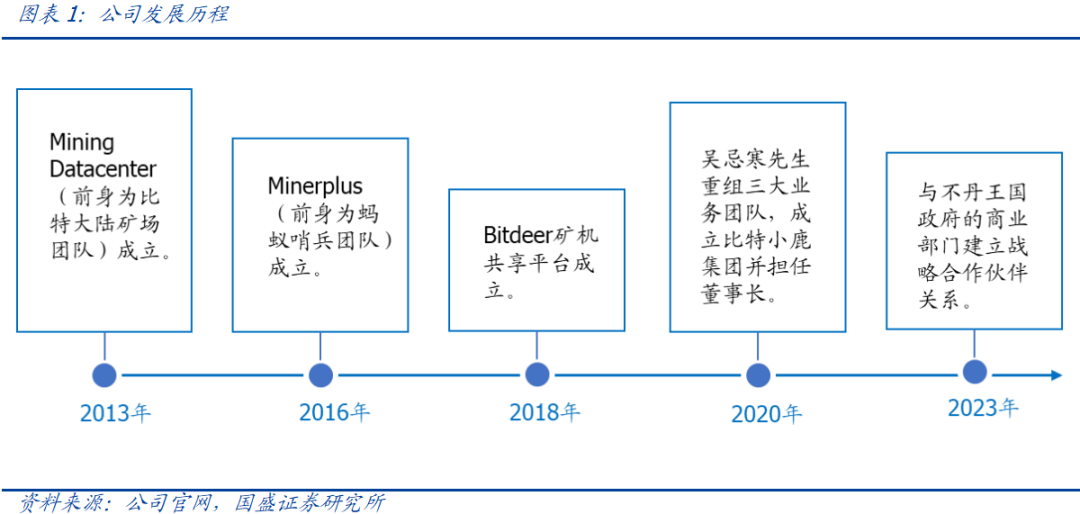
Bit Deer is committed to meeting the personalized mining needs of different users worldwide, playing an important role as a supplier of hardware, software, and various support services in the entire digital currency mining ecosystem. The three vertical business lines work together to create a complete mining ecosystem. The company's three main businesses consist of self-mining supported by its self-developed Minerplus, computing power sharing, and hosting services.
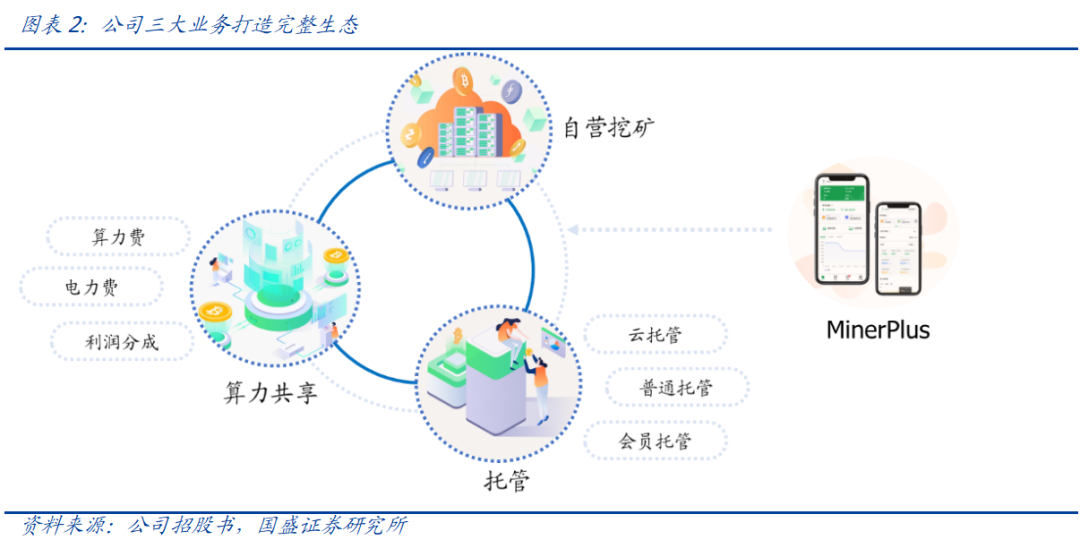
Among the three business lines:
- The self-mining business refers to the company mining cryptocurrency for its own account.
- The computing power sharing business provides two solutions: cloud computing power and computing power market, to support cryptocurrency mining activities globally with convenient, transparent, and reliable computing power. As of December 31, 2022, the revenue from the computing power market solution was relatively insignificant compared to total revenue, with the cloud computing power being the main source of revenue, among which:
- In the computing power market solution, the company acts as an intermediary connecting third parties (such as miners or mining farm owners) with clients in need of computing power, charging only a service fee.
The cloud computing power solution provides clients with computing power from the company's self-operated mining machines, with current packages available for 30/45/360 days; based on the charging method, they can be divided into classic mode and accelerated mode:
The classic mode fee consists of two parts: 1) Computing power fee, which is the fee clients need to pay when purchasing a cloud computing power package and connecting to a designated mining pool, which must be paid in full at the time of package purchase; 2) Electricity fee, which is the cost of maintaining the mining machines providing computing power, fixed at the start of each electricity subscription and can be paid in installments during the package period.
In the accelerated mode, the computing power fee that clients need to pay is relatively lower than in the classic mode, but after the client's costs are recovered, the company will receive a profit share. That is, in addition to the computing power fee and electricity fee, the company has the right to receive additional profits based on a percentage of the mining profits obtained by the client from the cloud computing power package.
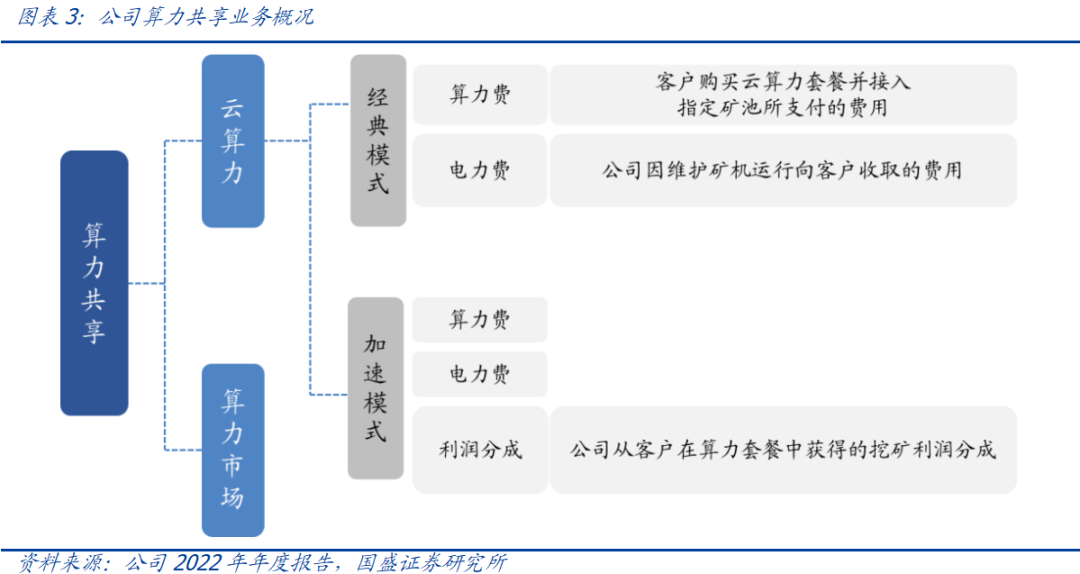
Hosting includes three types of services: cloud hosting, regular hosting, and membership hosting, to meet clients' diverse needs for professional hosting solutions and reduce the initial investment costs for mining farm construction, deployment, and operation, among which:
The cloud hosting model provides a "group purchase" service for mining machines, allowing retail miners to pool funds to purchase computing and maintenance services for the company's mining machines. The company plans to use the capacity for future mining farm expansion for regular and membership hosting services, while existing cloud hosting services will continue but will no longer be the mainstream product.
In both the regular hosting and membership hosting models, the hosted mining machines come from target clients, with the membership hosting model aimed at large miners seeking long-term stable hosting services. The company prioritizes meeting the hosting needs of members and offers discounts on service fees.

Revenue and net profit are highly volatile and significantly affected by Bitcoin prices. From 2019 to 2021, the company's revenue continued to rise, but in 2022, revenue decreased by 15.5% year-on-year due to the impact of coin prices. The company's net profit attributable to the parent company fluctuated greatly, peaking at $83 million in 2021, a year-on-year increase of 248%, and dropping to a loss of $60 million in 2022. In Q1-Q3 of 2023, as coin prices rebounded, the company's revenue and net profit attributable to the parent company were $250 million and a loss of $50 million, respectively, showing improvement compared to the declines in 2022.
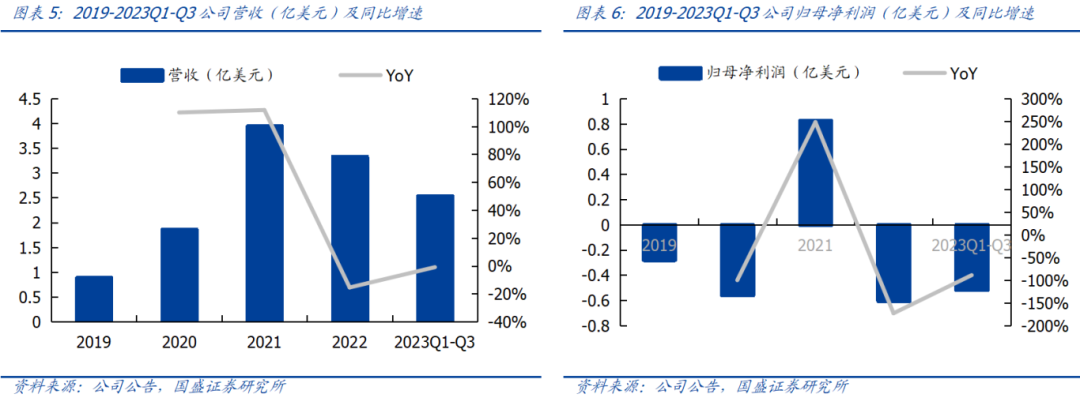
With three vertically integrated businesses, the company has the freedom to adjust its allocation strategy. The company's business relies on its mining farms and machines, and it has broad flexibility in pricing strategies and resource allocation, allowing it to adjust mining farm capacity and self-operated computing power allocation in response to market conditions. In 2022, the revenue share of self-mining business significantly shrank to 18.7%, while in Q1-Q3 of 2023, it reached 25.6%. After the company launched hosting services in 2020, its revenue share continued to rise, quickly becoming the main source of revenue, reaching 50.7% in Q1-Q3 of 2023. According to the company's operational report for December 2023, its self-operated computing power scale has reached 8.4 EH/s, a year-on-year increase of 105%.
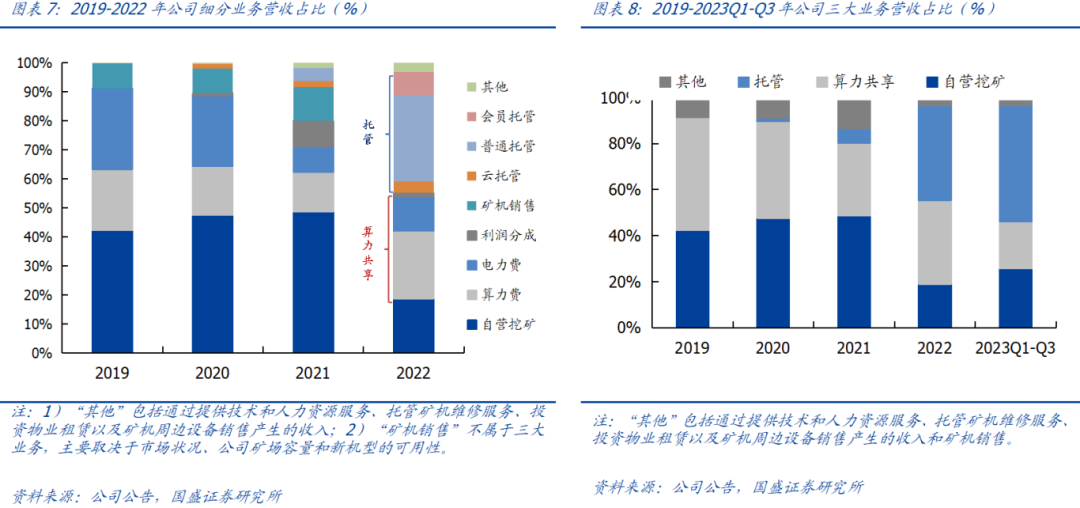
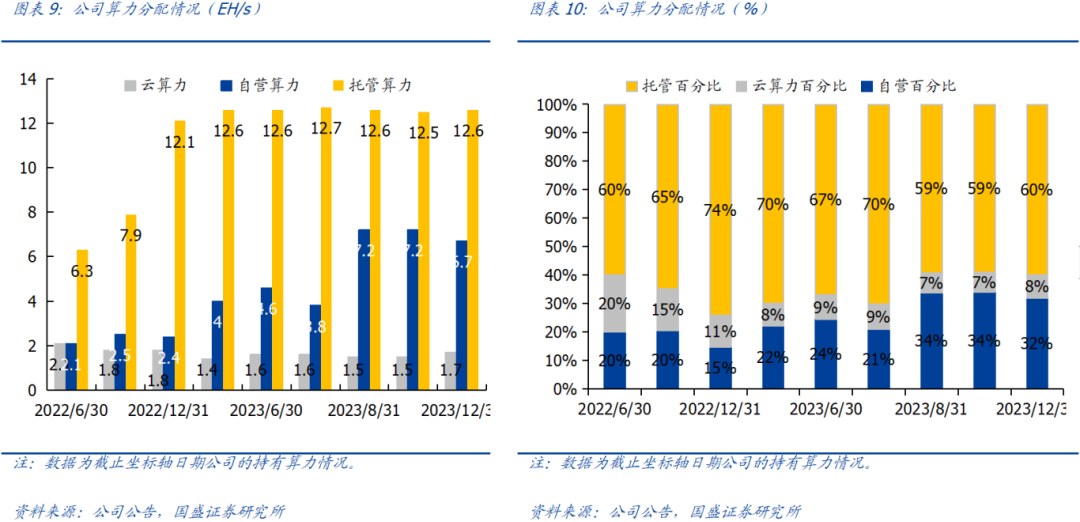
2. Halving Approaches, Mining Machine Prices Rise, Self-Developed Mining Machines May Become a Trend in the Mining Industry
2.1. Mining Machines are the Main Production Materials for Miners, Affecting Both Mining Income and Costs
Bitcoin is a medium of exchange and a store of value. It uses cryptographic techniques to control the creation of currency units and verify the transfer of funds. Many consumers use Bitcoin because it offers cheaper and faster peer-to-peer payment options without requiring personal information. Bitcoin features decentralization, global circulation, exclusive ownership, low transaction fees, no hidden costs, and can be mined across platforms without relying on third-party pricing institutions to determine its value.
Bitcoin has always maintained a dominant position among crypto assets. According to CoinMarketCap data, as of February 4, 2024, the total market capitalization of global crypto assets (including stablecoins and tokens) reached $1.65 trillion, with major crypto assets including Bitcoin, Ethereum, Tether, and BNB. Among them, Bitcoin, as the first crypto asset, has consistently held a dominant position in the market capitalization of cryptocurrencies, accounting for 51.21% of the total market capitalization of crypto assets as of February 4, 2024.
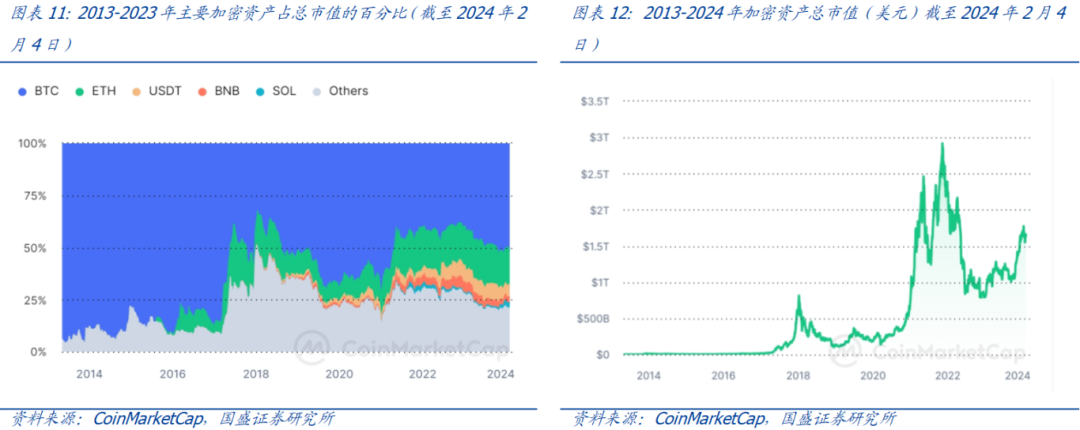
Blockchain is the underlying technology of Bitcoin. It is a decentralized digital ledger composed of a bottom-up data layer, network layer, consensus layer, incentive layer, contract layer, and application layer, capable of recording and achieving secure peer-to-peer transactions without third-party intermediaries, thus realizing the confirmation of digital asset ownership. When a user requests the blockchain network to process a transaction, a peer-to-peer network composed of mining machines (dedicated computers) uses known algorithms to verify the transaction, competing for the right to record the transaction.
Once a transaction is verified, a new data block is generated on the blockchain. The new block is added to the existing blockchain in a permanent and tamper-proof manner, completing the transaction. Each transaction and the ownership of every circulating digital asset are recorded on the blockchain. Each time a transaction occurs, mining machines update the BTC ledger.
Mining machines that successfully verify transactions receive Bitcoin rewards and transaction fees (Bitcoin is publicly issued in this manner). As of February 4, 2024, Bitcoin's market capitalization is close to $840 billion. The following conditions have been established:
1) Bitcoin was launched in 2009, and mining machines that "mine" new blocks can receive a reward of 50 Bitcoins, which is halved every four years. The current Bitcoin block reward is 6.25 Bitcoins (Note: Bitcoin rewards are sequentially 50-25-12.5-6.25, with the next halving expected in April 2024).
2) Regardless of the total computing power of the Bitcoin network, the block generation speed remains constant, with a new block appearing approximately every 10 minutes.
3) The current unit price of Bitcoin is approximately $42,842 (BitInfoCharts, February 4, 2024).
From the above, we can derive:
Theoretical daily block reward for Bitcoin = Block reward * (Total time in a day / Time taken to mine each block)
= 6.25 * (24 * 60 / 10)
= 6.25 * 144
= 900 (Bitcoins)
Theoretical daily block reward market price = Bitcoin price * Daily block reward for Bitcoin
= 42,842 * 900
= 38,557,800 (USD)
≈ 3,855.78 (million USD)
As of February 4, 2024, at 5 PM, the total block rewards and transaction fees across the network in the past 24 hours were 975 BTC and 186.53 BTC, totaling $49.75 million. Theoretically, by the year 2140, the smallest unit of Bitcoin will be mined, at which point miners will only receive transaction fees.
Bitcoin completes its "issuance" in this manner, with a total quantity of approximately 21 million. According to BitInfoCharts, as of February 4, 2024, 19,617,000 Bitcoins have been mined, with the unit price of Bitcoin at $42,842. As of February 4, 2024, the market value of all mined Bitcoins is approximately $840 billion.
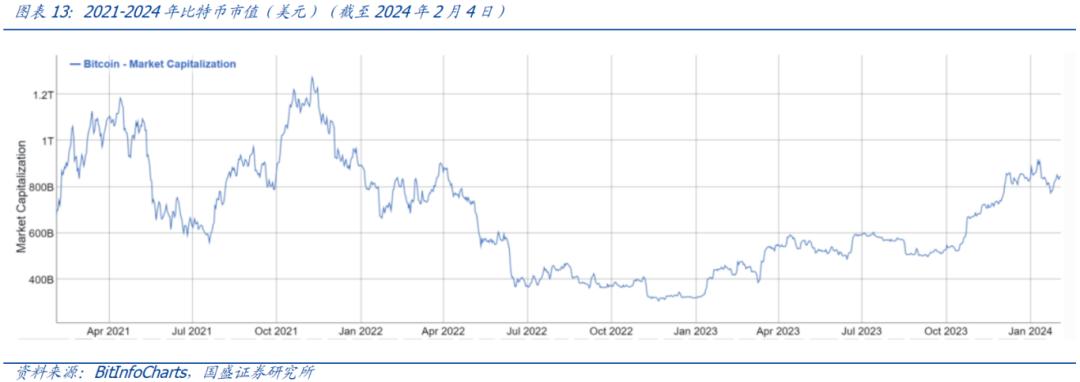
The income of miners from mining is directly related to their share of the total network computing power. During the mining process, miners need to solve a complex mathematical problem to prove their workload, and the difficulty of this problem determines how many hash operations nodes need to perform to generate a valid block. To maintain a constant rate of new block generation under changing total network computing power conditions, the difficulty must be adjusted according to changes in total network computing power, where the relationship exists:
Time taken to mine each block (constant at around 10 minutes) = Difficulty * 2^32 / Total network computing power
Rearranging gives "Difficulty = 10 * Total network computing power / 2^32", meaning that the higher the total network computing power, the greater the mining difficulty. The daily mining income of miners depends on the number of Bitcoins mined daily and the coin price, which can be calculated as:
Daily mining income = Daily Bitcoins mined * Coin price
= (Owned computing power / Total network computing power) * Daily block reward for Bitcoin * Coin price
Since the daily block reward and coin price are the same for all miners, a miner's income from mining is only related to their share of the total network computing power; the larger the share, the more mining income.
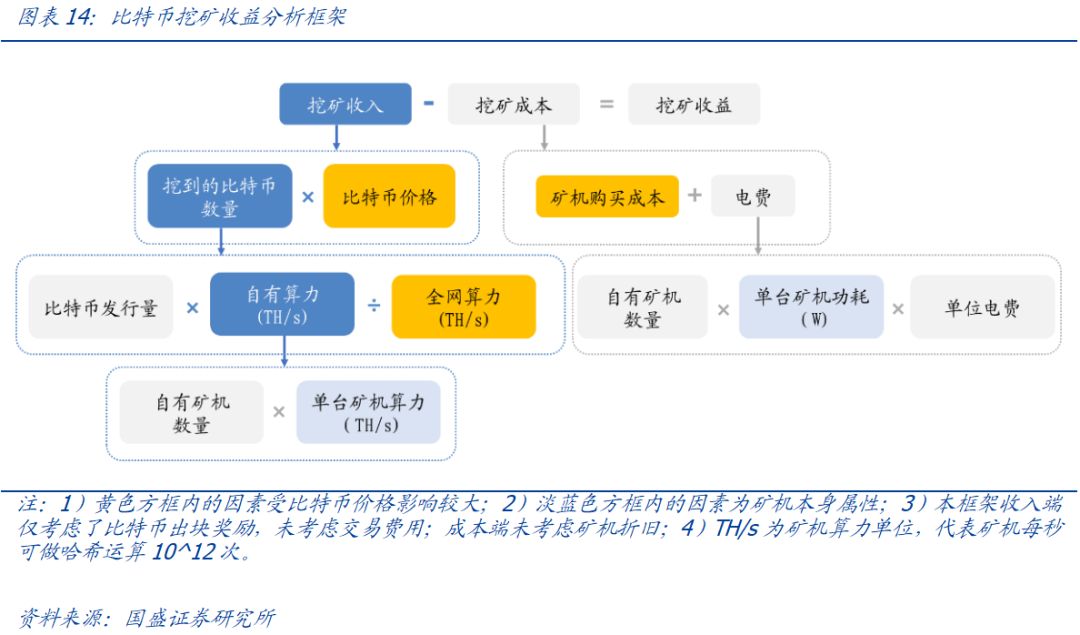
The income from Bitcoin mining is mainly affected by mining difficulty and electricity costs. Since the mining difficulty (which determines unit mining income) and coin price are the same for all miners, a miner's income from mining is only related to their mining machine's computing power. Therefore, the main factors affecting mining costs are the power consumption of mining machines and electricity costs, with the energy efficiency ratio (J/TH) of mining machines being a key indicator to watch. For mining machines with the same computing power, mining income is the same, but machines with lower energy consumption incur lower electricity costs, meaning that theoretically, mining income is higher.
2.2. The Halving is Approaching, Mining Costs are About to Double, Only High-Performance Mining Machines Will Not Be Eliminated
Bitcoin halving refers to the event where the number of Bitcoins miners receive as a reward for processing transactions is halved. Since Bitcoin's launch, halving has occurred on three different occasions. The first halving occurred on November 28, 2012, the second on July 9, 2016, and the most recent halving occurred on May 20, 2020. The Bitcoin rewards are sequentially 50-25-12.5-6.25, with the next halving expected in April 2024.
For mining companies, Bitcoin halving means their income is reduced by half, which translates to doubled costs under the same income. The key to controlling mining costs lies in the power consumption and electricity costs of mining machines, particularly where there is significant room for improvement in the performance of mining machines (reflected in the energy efficiency ratio J/TH).
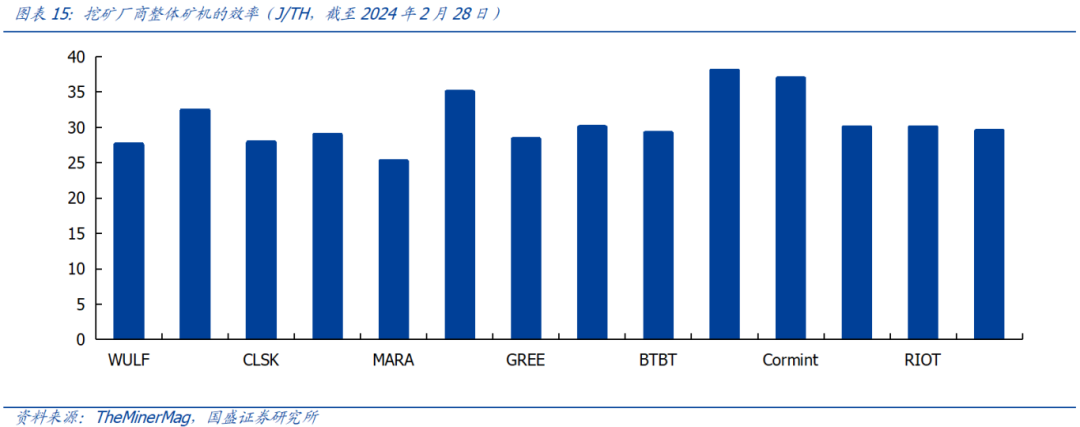
Currently, the overall level of mining machines from manufacturers varies significantly, leading to noticeable differences in computing power costs. Considering the impending surge in costs due to the upcoming Bitcoin mining halving, only more efficient and advanced mining equipment can ensure mining profitability and prevent mining machines from being eliminated from the market.
2.3. Bitcoin Prices Have Risen for Over a Year, Driving Up Mining Machine Prices, Self-Developed Mining Machines May Help Miners Reduce Costs and Increase Efficiency
With Bitcoin prices rebounding from the bottom, the mining market is beginning to recover. The price of Bitcoin is the "ultimate factor" affecting miners' income. Ultimately, the mainstream way for miners to earn income is by selling the mined coins, whether in the short term or long term after mining. According to MacroMicro, in May 2022, the average mining cost exceeded the value of a unit of Bitcoin, leading many miners to choose to exit the market or shut down their machines, resulting in the first decline in total network computing power since 2021. In 2023, Bitcoin prices rebounded from their lows, and as of February 4, 2024, the price of Bitcoin has risen from $16,000 on November 11, 2020, to $43,000, an increase of 175%. The overall price of Bitcoin has emerged from the bear market, boosting confidence and reviving the mining market. According to BitInfoCharts, the daily average computing power across the network reached 582.403 EH/s on February 4, 2024.
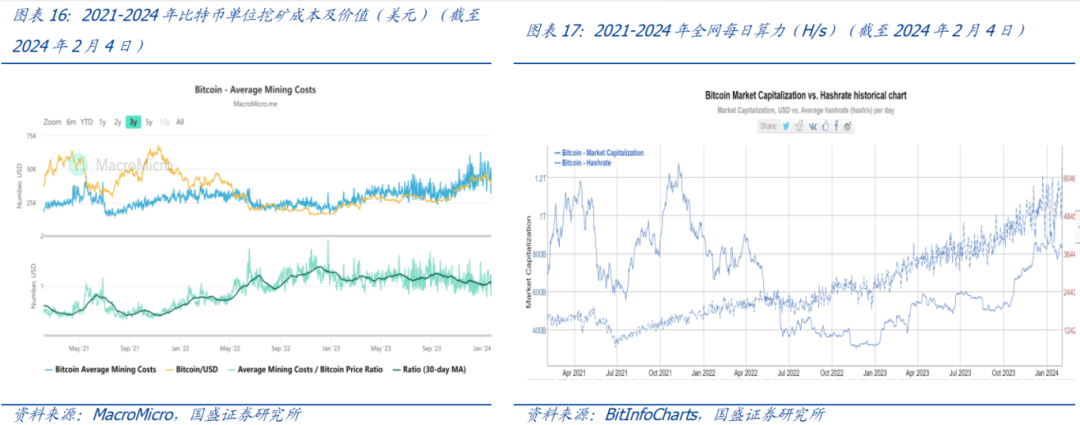
The trend of computing power centralization has emerged. As mining difficulty increases and Bitcoin production decreases, traditional miners focused on short-term investment returns are exiting the market, leaving behind more mining entities linked by institutional mining farms, computing power product centers, and state capital mining farms. According to TheMinerMag data, in December 2023, the top 10 listed mining companies accounted for 18.82% of the total Bitcoin production across the network, with Marathon (MARA) accounting for 5.05% of the total Bitcoin production that month. With the recovery of Bitcoin prices, competition for computing power has intensified again; according to BitInfoCharts, the daily average computing power across the network reached 582.403 EH/s on February 4, 2024, a year-on-year increase of 124.5%.

According to Hashrate Index data, mining machine prices have already risen. Over the past year, Bitcoin prices have continued to rise, while mining machine prices remained relatively low. Starting from the end of 2023, mining machine prices have begun to "rise," showing an upward trend. With the upcoming Bitcoin halving, the demand for high-performance mining machines is expected to increase, and mining machine prices are likely to continue to rise in the future.
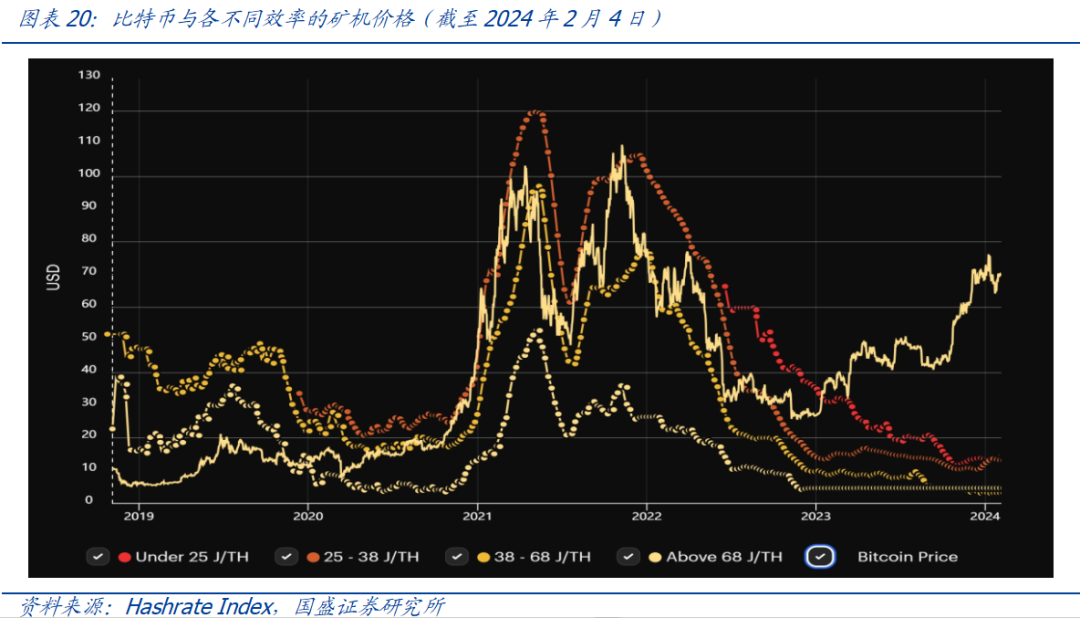
Bit Deer's self-developed mining machines are expected to reduce costs and increase efficiency. As a mining company, all three of its main businesses are closely related to the performance of mining machines. Developing its own mining machines is beneficial for further business expansion and helps the company cope with the upcoming halving and rising mining machine prices.
We expect more mining companies to begin developing their own mining machines. In summary, since the efficiency of mining machines is key to the income and costs of mining companies, and the upcoming halving and rising mining machine prices are common challenges faced by all manufacturers, at this stage, the overall efficiency levels of mining machines vary among manufacturers due to issues such as batch procurement and product updates. Under the demonstration of Bit Deer taking the lead in developing its own mining machines, manufacturers with relatively high energy efficiency may seek to surpass through self-development, while those with lower energy efficiency will also consider self-development to maintain their competitive edge.
Risk Warning
Bitcoin prices may decline. Bitcoin's history is limited, and its fair value is highly volatile. The historical performance of Bitcoin prices does not represent its future performance, as its price is influenced by various factors and carries significant uncertainty.
Stricter regulations on Bitcoin in various countries. There is significant uncertainty regarding future regulations concerning the holding, use, or mining of Bitcoin. Due to Bitcoin's anonymous nature, it may be used for black market transactions, money laundering, illegal activities, or tax evasion, leading governments to regulate, restrict, control, or prohibit Bitcoin mining, use, and holding.
Electricity supply may fall short of expectations. Mining requires a large amount of low-cost electricity. Adverse weather, policies, or local power supply limitations may hinder mining activities from obtaining sufficient electricity supply, thereby affecting mining income.
Computing power improvements may not meet expectations. As Bitcoin prices rise, the supply of mining machines increases. If miners cannot timely acquire new high-performance mining machines, they may struggle to maintain an advantage in the intensifying competition for computing power, significantly negatively impacting their business operations.
This article is excerpted from the report "The Path of Integrated Consolidation in the Overseas Bitcoin Mining Industry," published by Guosheng Securities Research Institute on February 29, 2024. For specific content, please refer to the relevant report.









